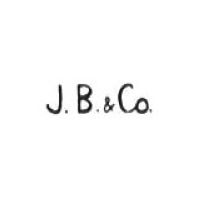
Image 010249-01-01
Used between 1884 and 1887, the initials of course stand for 'Jena, Bareuther & Co.'.
In 1866 the former chief potter of the C.M. Hutschenreuther factory in Hohenberg, Johann Mathäus Riess (born in Ottenlohe near Hohenberg) founded his own pottery in Waldsassen but died only a year later. The impressingly successful business was taken over by his son Johann Riess, who in 1875 also started producing porcelain. Over the next years, young Riess ran into more and more problems which finally forced him to sell the facility to Wilhelm Schreider from the town of Schwarzenhammer in 1884 as the facility employing 100 people at the time was nearly bankrupt. Schreider himself then sold the facility a year later.
The industrials Max Jena (Selb, Bavaria), Ernst Ploß (Asch, Bohemia) and Oskar Bareuther (Haslau, Bohemia) took over and after modernizations started to slowly but surely increase quality and output. Max Jena left the company in 1887, resulting in a rename of the company.
Bareuther and Ploß constantly improved the facility and the success they were having slowly let the workforce increase to 150 people in 1890. Further improvements and expansions followed, leading to a total of seven normal round kilns and one dedicated decoration kiln, followed by an even larger workforce as more and more skilled workers joined the company. In some areas like decoration styles, the company started to cooperate with others like the Porzellanfabrik Königszelt AG in Silesia, which resulted in a constant technology transfer between both companies - the best known would be the 'Indisch Blau' decoration style.
Based on the high quality standards, company reputation literally exploded. To cope with the demand, even further investments were needed to optimize the production process and these were made possible after the businessman R. Schmerler from Eger joined the company in 1902. One of the technical additions was the installation of a 130hp steam engine ordered at the Maschinenfabrik Heinrich Rockstroh from the town of Marktredwitz which was delivered and installed late in 1902. In the year 1904, the official workforce count showed an impressive number of 600 employees and on September 29th 1904 the company was transformed into a corporation.
The next years were relatively eventless and the workforce count for 1913, like 1906, showed a number of 600 employees. By 1930 the number had increased to 700, only to drop back down to 650 in 1937. The company itself (with an impressive number of twelve large kilns) was one of the top players in the porcelain industry, setting standards in quality assurance and investment strategies, a point that should pay off later as it helped the company recover after the war.
During the second world war, the facility was nearly completely destroyed and the former impressive workforce was shattered. Even if the facility was a ruin, its board of directors was completely functional and after the war one of the first steps was to contact the former workers of the Porzellanfabrik Königszelt AG, who were practically homeless as the former Silesia had been declared Polish territory and all remaining Germans were forced to leave.
Needless to say, it only took a short time for the word to spread and most workers found a new job at 'Bareuther & Co.' - it was time to restart. With enormous financial effort completely covered by company funds, the combined workforce started providing housing possibilities for the refugees and then started to rebuild the facility - it was one of the first large facilities to be fully operational in 1949 and already having a workforce of 417 people. It should be noted here that in commemoration of the long-time cooperation and the events after the war, the company created the factory mark 'Königszelt Bayern' (Königszelt Bavaria) in the year 1979.
First items had been produced again from 1947 onwards, but these were only cheap and basic products to cover the demand in shattered Germany. As one of the first regulars back in the market, the company slowly increased its product range and soon one the largest manufacturers in Germany again, especially during 1955 and 1965. Constantly expanding, the company merged with the Gareis, Kühnl & Cie. on July 1st 1969. This merger resulted in a total workforce of a thousand employees and a name change, proudly hinting that it was now the only company in Waldsassen.
After the merger, the company increased their position on the market, soon to be rewarded by reaching rank number six of all German porcelain manufacturers. But its proud years slowly passed and especially from 1990 onwards the competition from low-wage countries started to take its toll and finally led to more and more dismissals. The company had to file for bankruptcy in 1994 and was erased from the trade register 1996. After the closure various attempts to sell the facility failed mainly because of the enormous amount of money needed for decontamination of the polluted soil, a result of the many chemicals used in porcelain production. In the year 2002 the state of Bavaria itself had to stand up for the process as the contaminated areas were endangering the ground water supply; demolition of the abandoned factory started in 2006, making room for a shopping center.
People have often asked me who actually made all the Bareuther Christmas plates and similar editions after the original Bareuther factory closed in 1994. Thanks to information provided by Mr. Manfred Blieske in September 2009, I can now fully answer that question. They were all made by one company, however the company changed its name three times in short succession: Until 2000 they were made by the SKV-Porzellan-Union GmbH, between 2000 and 2003 by the SKV-Arzberg-Porzellan GmbH and from 2004 onwards by the Arzberg Porzellan GmbH. The most confusing part however concerns the marks all three iterations of the factory used, the 2009 Christmas plate for example actually had the Bareuther "125 years anniversary" mark from 1991 on the box.

Image 010249-01-01
Used between 1884 and 1887, the initials of course stand for 'Jena, Bareuther & Co.'.
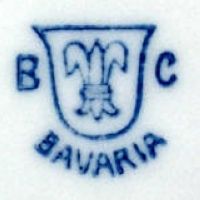
Image 010249-04-01
Used between 1920 and 1945, stands for 'Bareuther & Co.'.
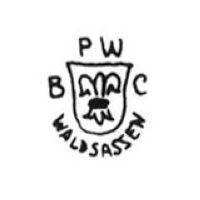
Image 010249-04-02
Used between 1920 and 1945. Registered at the RWZR under №·246·872 on May 11th 1920.
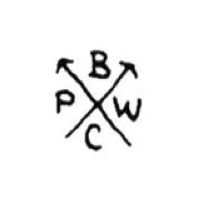
Image 010249-04-03
Used around 1920, stands for Porzellanfabrik Waldsassen Bareuther & Co.. Registered at the RWZR under №·247·307 on May 19th 1920.
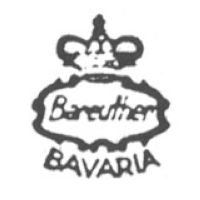
Image 010249-04-04
Used from 1925 onwards.
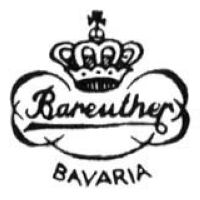
Image 010249-04-05
Used from 1931 onwards. Registered at the RWZR under №·439·726 on November 23rd 1931.
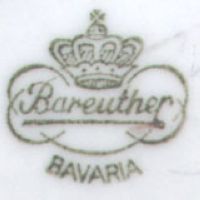
Image 010249-04-06
Used between 1937 and 1945. Note the slight difference of the writing and the crown.
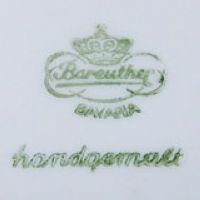
Image 010249-04-07
Same in green and with "handgemalt" addition.
(Picture: Debbie Tietze)
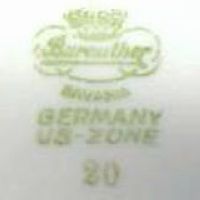
Image 010249-04-08
Used between 1945 and 1949. This is a later version as the "US-Zone"' is already included in the mark itself and not a mark addition.
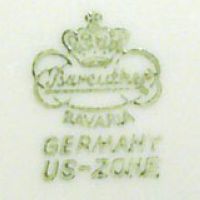
Image 010249-04-09
Used between 1945 and 1949. Another example with the "US-Zone" included.
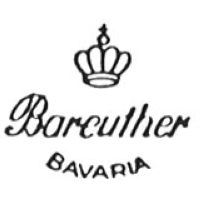
Image 010249-04-10
Used between 1956 and 1960, note "Bareuther" is cursive.
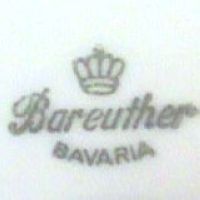
Image 010249-04-11
Used between 1956 and 1960, note "Bareuther" is cursive.
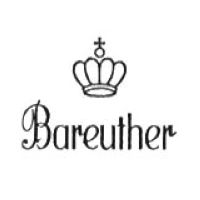
Image 010249-04-12
Used between 1960 and 1970, note "Bareuther" is normal.
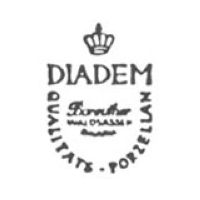
Image 010249-04-13
Used from 1964 onwards for the 'Diadem' series.
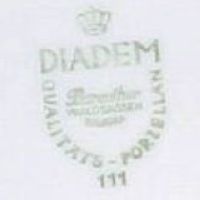
Image 010249-04-14
Example of the previously mentioned mark.
(Picture: Fran Kerbs)
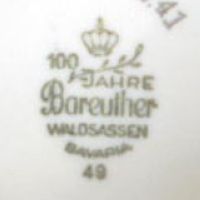
Image 010249-04-15
Anniversary mark introduced 1966. The laurel and the "100 Jahre" addition was used in varous combinations between 1966 and 1969.
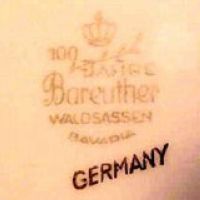
Image 010249-04-16
Anniversary mark introduced 1966, here with an additional "Germany" stamped next to the mark itself.
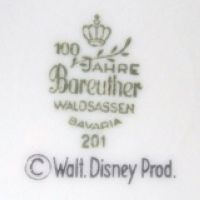
Image 010249-04-17
Anniversary mark introduced 1966, here another example on an item licensed by Disney.
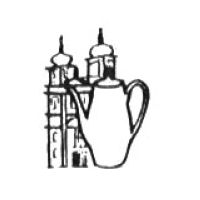
Image 010249-04-18
Used between 1966 and 1993 for special gift editions.
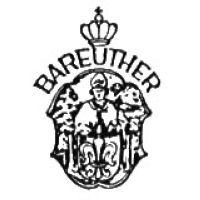
Image 010249-04-19
Used between 1966 and 1993, the basic version without any additions.
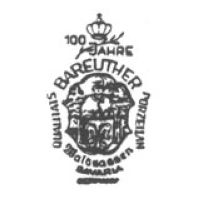
Image 010249-04-20
Used between 1966 and 1969, anniversary version.
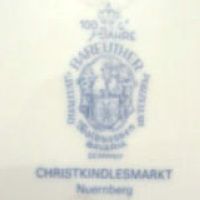
Image 010249-04-21
Used between 1966 and 1969, here on a plate for the famous Christkindlesmarkt, the Christmas market in Nürnberg.
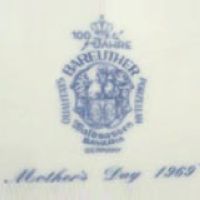
Image 010249-04-22
Used between 1966 and 1969, here on the 1969 Mothers Day plate.
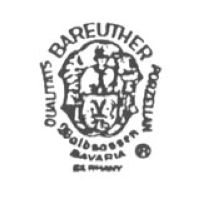
Image 010249-04-23
Used between 1967 and 1969, without crown or laurel but with a ®-mark at the bottom right.
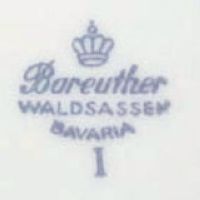
Image 010249-04-24
Used from 1967 onwards, here in blue.
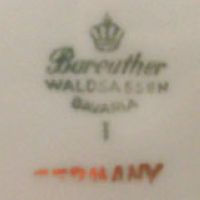
Image 010249-04-25
Used from 1967 onwards, here in green.
(Picture: Jeanna Grace)
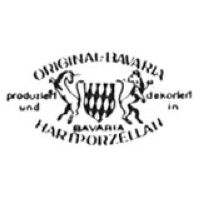
Image 010249-05-01
Used between 1969 and 1993, "Original Bavaria Hartporzellan, produziert und dekoriert in Bavaria".
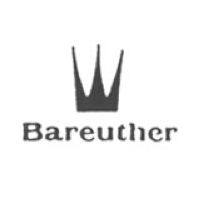
Image 010249-05-02
Used between 1970 and 1993.
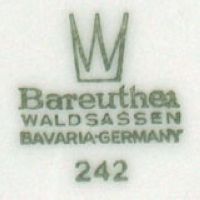
Image 010249-05-03
Used between 1970 and 1993, also used with the filled crown shown previously.
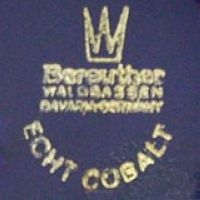
Image 010249-05-04
Used between 1970 and 1993, example of the previous mark on a cobalt-decorated piece.
(Picture: Fran Kerbs)
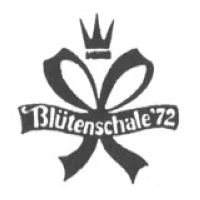
Image 010249-05-05
Used only in 1972 on a special edition for the Muttergenesungswerk.
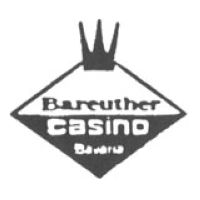
Image 010249-05-06
Used from 1975 onwards for the Casino series.
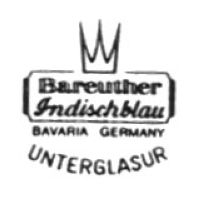
Image 010249-05-07
Used between 1975 and 1993 for the "Indisch Blau" series.
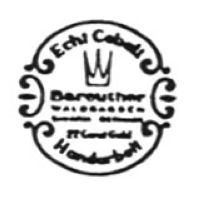
Image 010249-05-08
Used between 1975 and 1994 for the "Echt Kobalt" (cobalt decorated) series.
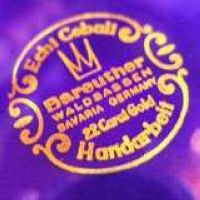
Image 010249-05-09
Example of the previously mentioned mark.
(Picture: Fran Kerbs)
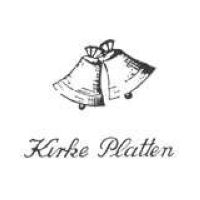
Image 010249-05-10
Used between 1968 and 1993, mark on "Kirke Platten" collector plates only.
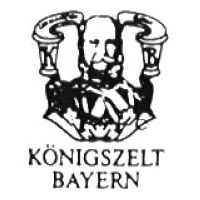
Image 010249-05-11
This mark is was used in commemoration of the Porzellanfabrik Königszelt AG (Silesia) and introduced 1979.
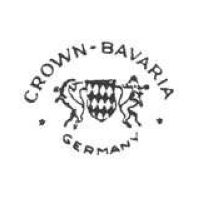
Image 010249-05-12
Used between 1982 and 1993, "Crown-Bavaria" and "Germany".
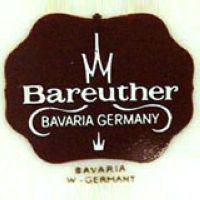
Image 010249-05-13
Used between 1986 and 1993, solid version.

Image 010249-05-14
Used between 1986 and 1993, frame version.

Image 010249-05-15
Used between 1987 and 1993.
© 2004-2026 C.S.Marshall, all rights reserved